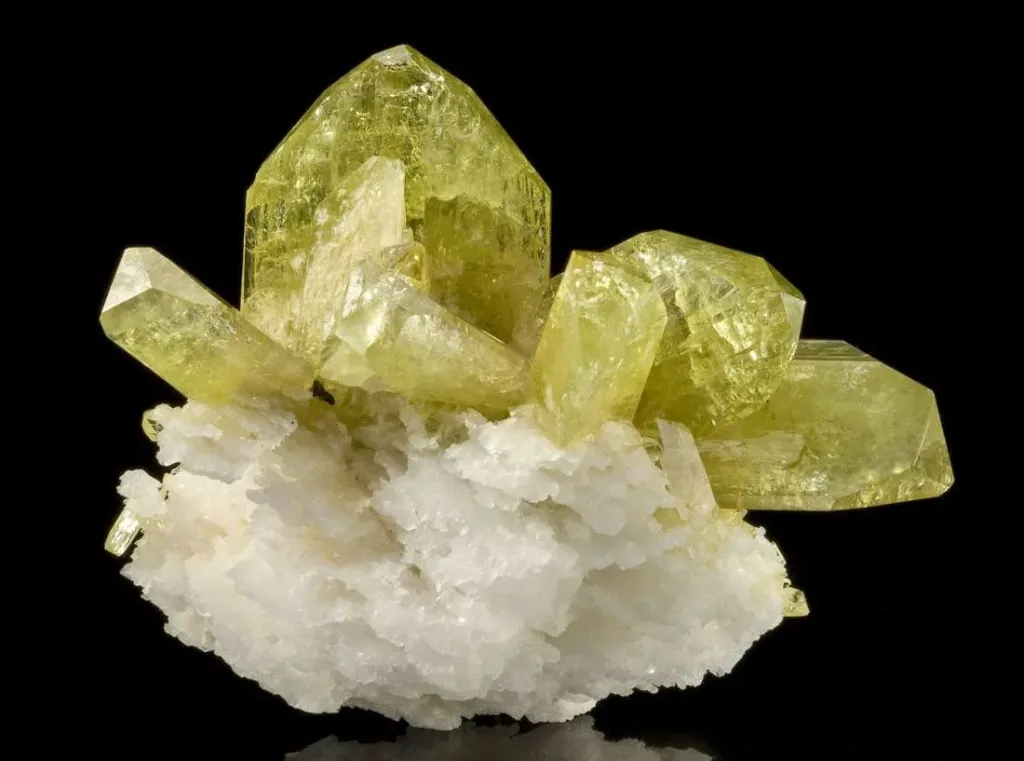
Appearance
The most striking characteristic of Brazilianite is its vivid green to yellowish-green hue. Green can have a range of shades and intensities, from light and pastel tones that are deep and powerful. It might also display yellow or yellowish-green hues under some lighting circumstances. Brazilianite has a vitreous luster, which gives it a polished, glassy, and shiny appearance. The monoclinic crystal system is where Brazilianite crystallizes. Its crystals are lengthy, prismatic or tabular in shape, and they frequently have striations running parallel to their length.
Geographical Distribution
Brazil is the main source of Brazilianite, especially in the states of Minas Gerais’s Linópolis and Conselheiro Pena districts. Additionally, it can be found in smaller amounts in the US, Namibia, Afghanistan, Portugal, and Russia.
History
Brazilian geologist Djalma Guimarães made the initial discovery of Brazilianite in the Brazilian state of Minas Gerais in 1944. Guimarães gave the mineral the name “Brazilianite” in remembrance of its native nation. The initial finding was made in the Linópolis area of the Conselheiro Pena pegmatite district.
Metaphysical Properties
Beyond its aesthetic value, Brazilianite is said to have spiritual qualities by some people. It is thought to improve one’s capacity for self-expression, creativity, and power. Brazilianite is frequently linked to the solar plexus chakra, which is connected to manifestation, self-assurance, and willpower. It’s crucial to remember that these opinions are purely subjective and unsupported by data from science.

Chemical Composition
Brazilianite’s chemical composition is given by the formula NaAl_3(PO_4)_2(OH)_4. It is a mineral that is phosphate and a member of the apatite group. To comprehend the composition of the formula, let’s dissect it:
Na is an acronym for sodium, an alkali metal.
Aluminum is a common metal element, and its symbol is Al_3.
Phosphate, abbreviated PO_4, is a class of chemicals that includes both oxygen and phosphorus.
The hydroxyl group, denoted by OH, is made up of one oxygen atom bound to one hydrogen atom.
Uses
Brazilianite is a valuable gemstone that is mostly sought after for its aesthetic features. It is a sought-after addition to jewelry and gem collections because of its rarity, vivid color, and distinctive crystal structure. Brazilianite gemstones are usually faceted to bring out the beautiful green to yellowish-green color and increase their brilliance.
Brazilianite is mostly used to make jewelry, however it’s vital to remember that because of its flawless cleavage and moderate hardness, handling Brazilianite carefully is necessary to avoid breaking or damage. It works well with jewelry that won’t be subjected to a lot of wear or potential damage.
Beyond its usage as a decoration, Brazilianite has few practical industrial uses. Its tiny crystal sizes and rarity make it unsuitable for large-scale industrial procedures. Within the gem and mineral collecting world, Brazilianite is mostly prized for its beauty and rarity.
Brazilianite is mostly used in the field of gem and mineral collecting, where it is highly valued due to its remarkable color and rarity. It is a valued gemstone among collectors and those looking for distinctive and exquisite jewelry pieces due to its exquisite beauty and limited supply.
Table





